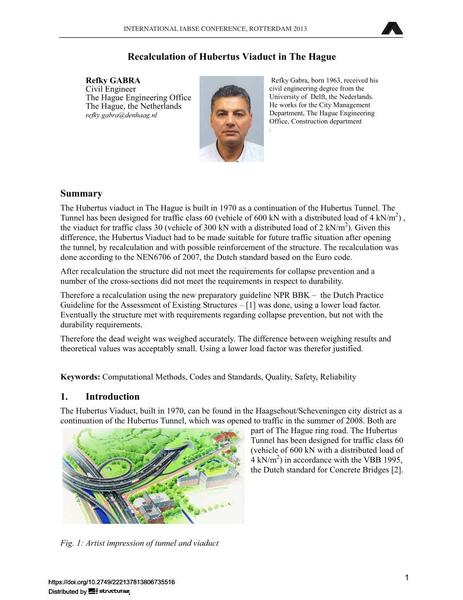Recalculation of Hubertus Viaduct in The Hague

|
|
|||||||||||
Détails bibliographiques
| Auteur(s): |
Refky Gabra
|
||||
|---|---|---|---|---|---|
| Médium: | papier de conférence | ||||
| Langue(s): | anglais | ||||
| Conférence: | IABSE Conference: Assessment, Upgrading and Refurbishment of Infrastructures, Rotterdam, The Netherlands, 6-8 May 2013 | ||||
| Publié dans: | IABSE Conference, Rotterdam, May 2013 | ||||
|
|||||
| Page(s): | 214-215 | ||||
| Nombre total de pages (du PDF): | 7 | ||||
| Année: | 2013 | ||||
| DOI: | 10.2749/222137813806735516 | ||||
| Abstrait: |
The Hubertus viaduct in The Hague is built in 1970 as a continuation of the Hubertus Tunnel. The Tunnel has been designed for traffic class 60 (vehicle of 600 kN with a distributed load of 4 kN/m²), the viaduct for traffic class 30 (vehicle of 300 kN with a distributed load of 2 kN/m²). Given this difference, the Hubertus Viaduct had to be made suitable for future traffic situation after opening the tunnel, by recalculation and with possible reinforcement of the structure. The recalculation was done according to the NEN6706 of 2007, the Dutch standard based on the Euro code. After recalculation the structure did not meet the requirements for collapse prevention and a number of the cross-sections did not meet the requirements in respect to durability. Therefore a recalculation using the new preparatory guideline NPR BBK – the Dutch Practice Guideline for the Assessment of Existing Structures – [1] was done, using a lower load factor. Eventually the structure met with requirements regarding collapse prevention, but not with the durability requirements. Therefore the dead weight was weighed accurately. The difference between weighing results and theoretical values was acceptably small. Using a lower load factor was therefor justified. |
||||
